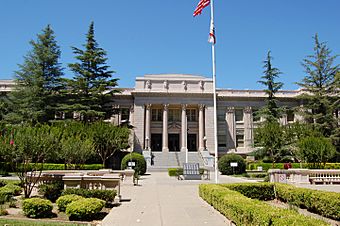Yolo County Courthouse facts for kids
Quick facts for kids |
|
|
Yolo County Courthouse
|
|
|
U.S. Historic district
Contributing property |
|

The Yolo County Courthouse as it appeared in 2011.
|
|
| Location | 725 Court St., Woodland, California |
|---|---|
| Built | 1917 |
| Architect | William Henry Weeks |
| Architectural style | Beaux Arts, Spanish Revival |
| Part of | Downtown Woodland Historic District (ID99000471) |
| NRHP reference No. | 86003660 |
| Added to NRHP | February 26, 1987 |
The Yolo County Courthouse is an important building in Woodland, California. It used to be a courthouse for the Superior Court of California in Yolo County until 2015. The first courthouse building was built in 1864. It was used for 37 years before it was declared unsafe in 1911. The current building was built in the same spot in 1917. It was added to the National Register of Historic Places in 1987. This means it is a special building recognized for its history. It is also part of the Downtown Woodland Historic District.
Contents
History of the Courthouse
The First Courthouse (1864-1911)
The land for the first courthouse was given to the county by Frank Freeman. He was one of the people who helped start Woodland. He offered a whole city block for the building. An architect named Albert Bennett from Sacramento designed the building. He also helped design parts of the California State Capitol.
A builder named P. McManus was chosen to construct the courthouse. He was hired in 1863 and finished the building in 1864. It was a two-story brick building in the Italianate style.
Over time, several earthquakes hit the area. Earthquakes in 1892, 1904, and 1906 damaged the building. They weakened its structure and hurt the air system. By 1908, one judge even moved his court out because of a bad smell. In 1911, officials decided the building was "unsanitary and unfit" for court business. This meant it was not clean or safe enough to use.
Building the New Courthouse (1911-1917)
After the first courthouse was declared unsafe, officials wanted to build a new one. In 1911, they asked the public to approve a plan to borrow $300,000 for a new building. But the people did not agree. They tried again later that year, but it failed once more. So, the court offices had to move to other places for a while.
In 1916, the county leaders tried again. They asked for $200,000 this time. The citizens voted yes, and the old courthouse was torn down. This made space for the new building. A big celebration was held when the first stone of the new courthouse was laid. About 3,000 people came, and all businesses and schools closed for the event.
William Henry Weeks was the architect for the new building. He designed many buildings in Woodland, including the Woodland Public Library. The new courthouse was finished in 1917. It cost about $300,000 to build.
The courthouse was updated inside during the 1980s. It was added to the National Register of Historic Places in 1986. The building used to hold other county offices, but as the courts grew, those offices moved out. The courthouse is still used today, but it needs more space.
Architecture and Design
The new courthouse building shows styles from Greek, Roman, and Renaissance architecture. It has two full floors, plus an attic and a basement. The outside is made of concrete that looks like Colusa sandstone. The decorative parts at the top, called cornices, were made from terra cotta (a type of baked clay).
The architect, William Henry Weeks, was very proud of his work. He once said, "This courthouse is the most beautiful in California."
Inside, the courthouse has a round hall called a rotunda on both the second and third floors. A main hallway runs through the building. The rotundas have marble columns that are flat against the wall. These are called pilasters. There are also decorative paintings in special curved spaces called niches. Both the rotundas and hallways are made of shiny marble. They have copper handrails and unique, egg-shaped glass lights.




